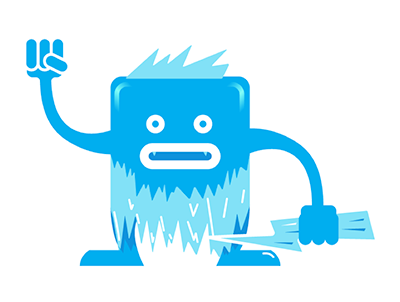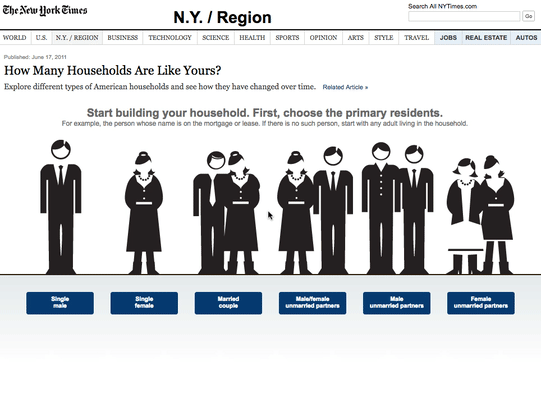Dataland
Data as a source for creativity

This is the written version of the talk that Sonia Jalfin gave in La Nación. If scrolling does not overwhelm you, go ahead with the reading! If you like videos, you can watch it here (in Spanish):
A good part of our work is to catch other people’s attention. We need toso they can implement our ideas, buy our products, hire our services and much more.
We might think that catching people’s attention should be easy today -we have more communication tools than ever, that are more sophisticated, easy to use and cheaper. But in real life it is not that simple. We have trouble taking advantage of all these channels because we are constantly being stalked by three fearsome monsters.

Here they may seem nice, but they are not. They do ruthless things to us.
The first one makes us tremble.
The second one can freeze us.
The third one has the power of fire, it burns us.
Hello, monster of change
This monster shakes the floor under our feet.

From the organizations we work in, to the technology we use, everything is constantly changing. We have nothing to hold on when everything around us is moving.
Whatever industry we work in, the risk of being hacked by new players, probably from other industries or by external factors, ranges between being a latent threat to an absolute certainty.
An icy monster
Our audience freezes us

Every message we send to a citizen, a customer or a user will be competing on their cell phone with a friend’s photo, a celebrity’s story or a message from his mother.
If our users are teenagers we can have some chances that they will pay more attention to us than to their mothers, but not always.
Last year’s Mery Meeker report at the Code Conference, one of the most respected trends analysis on the web, showed that 81% of users mute the audio when seeing a advertisement on the web.
The burning monster
The third monster burns our head

We are overwhelmed with the enormous amount of data and information we receive.
The Internet Observatory in Argentina, whose platform we developed in Sociopublico, shows that 69,978 hours of videos were viewed on YouTube since you started reading this note, approximately 90 seconds ago, and 20,972 tweets were published. And this is only in Argentina!

Data to the rescue!
How can we manage to be heard in the middle of this frenzy?
That is the question that makes us sleepless at Sociopublico. Because we are dedicated to communicate complex ideas and we know that the only way to be heard is to build something that is truly relevant to others. Something that serves them and speaks directly to what interests them.
One of the most fruitful ways to explore this is the world of data. It’s not just about using analytics to better segment a video or choose the right time to publish something. That’s good, but there is something else we can do: take the data generated by our activity and use it as raw materials for our own communication. Data can be the central input and protagonist of a relevant communication, one that reaches and engages with the public: data can integrate into our conversation and add value to what we do.
Here we share four ideas to include data as the center of our communications:
1. Data to build public goods
Data — public or private — can be an input to build public goods. Telefónica in Argentina, a telco company, shared its data with the government of the city of Neuquén to create a better urban mobility plan. MasterCard shared this year their data on business trips and analyzed them with Harvard researchers to better understand how the movement of people with a lot of knowledge influences the economy of countries. Whether you look at this from the point of view of an organization that produces knowledge, from a government, or from a company, this path opens up new possibilities and allows you to join forces in a way that until recently was impossible.
2. Data as a service
Data can also provide a service. Be useful to someone. Properati, a real estate company, took the inventory of trees in the city and matched their location with the housing offer, creating a tool that’s useful for those allergic to the platanus seeds, a very allergenic and popular tree in Buenos Aires, so they can know where it’s safe for them to move to.
3. User centered data
Sometimes in order to show clearly how data relates to our audience, it’s enough just to reorganize the existing data. In this way data is a mirror, not a projector. Here is an example of this.

This is an interactive by the NY Times with the census data from the United States. Instead of showing all the available data — the immensity of data that makes a census — they began by asking the user about theirfamily. That allows them to tell them information relevant to their families, and not about the statistical data that is quite far from us.
4. Data as experience
Many times people won’t remember what we said, but they will remember how we made them feel. This can also be achieved with data-based communication. Take this case:

This is a bread with tomato, a typical Catalan food. But it is not any bread with tomato. This bread came out of ‘data cuisine’, a hackathon of chefs, designers and programmers. It shows the evolution of youth unemployment in Spain. The green line is the growing youth unemployment rate. As unemployment increases, bread has less and less tomato, becoming drier and harder to eat. So, when you eat this bread with tomato, we literally swallow a piece of information. Quite an experience.
To sum up, we can use data to build public goods, services or experiences. We need all these ideas. They all ultimately point to the same goal: connect with others. If we succeed, our audience is more likely to listen to us, and we can keep the monsters at bay.

Read more

What comes after social media?
For quite some time, social media has been portrayed as the antagonists in an endless Netflix like series, much like the endless scroll we navigate with our fingers. They’re a sinister character in the sense Freud described, naming something as familiar as it is terrifying. There’s nothing more familiar than logging into Instagram, X, or […]
Learn more
Are we communicating information that our audiences don’t want to receive?
Communicating policy in a world of too much information
Learn more
What we can learn from coronavirus to improve remote working
Unexpected global circumstances force us to use new tools and learn new practices to adapt to telework. We compiled expert advice to navigate this ‘free sample’ of the future of work.
Learn more
From OOO to OHH! Tools to improve the out of office message
Even though we should have learned throughout the holiday season to distrust each “new message” notification, they still get our interest. This time of the year is terrible. So many times, instead of the expected reply to our message, we receive automatic emails with the subject: “out of the office”.
Learn more
Marikondoing at work: the life-changing magic of ordering files
Some practical tips to organize our workflow when we share files with other people
Learn more
Green eggs and ham
While we wait to see if and how our habits will change, the peak of experimentation is providing algorithms with great insights
Learn more
TikTok, social media challenges and live streaming: communication strategies during the pandemic
There is only one correct way to wash your hands, but there are a thousand ways to communicate it. There are also plenty of ways to stay home but not feel lonely, thanks to creativity in social media. And there are new territories to explore, like TikTok.
Learn more
Branding Covid-19: a name, a logo and a slogan
Language is changing to capture what we are going through (and we are going through a lot)
Learn more
World Cup armbands won’t change the world
Problems in the global communication of such important issues as climate change, humanitarian catastrophes and migratory crises.
Learn more
How to develop a data project without panicking / losing your mind
Tips for companies and organizations eager to work on their data
Learn more